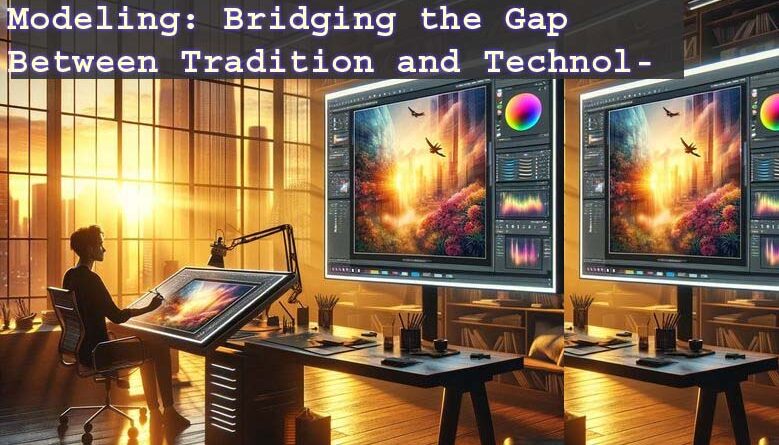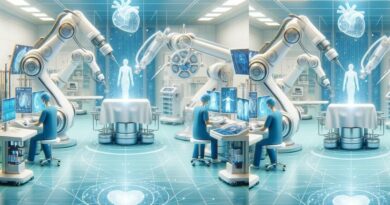AI-Driven Enhancements in 3D Modeling Bridging the Gap Between Tradition and Technology
Enhancing Content Creation 3D Modeling
AI improvements streamline the content material introduction process in 3D Modeling, offering gear that mechanically generate complicated textures, realistic lighting, and designated environments. These enhancements now not simplest shop time but also beautify the pleasant of the very last product.
Increased Accessibility for All
The integration of AI in 3-D modeling makes the generation extra accessible to a broader target audience. Beginners can now produce remarkable models without full-size training, way to intuitive interfaces and automatic features. This democratization of three-D modeling encourages extra humans to explore and contribute to the sector.
Historical Context of 3-d Modeling
Automation of repetitive responsibilities in 3-d modeling has been a large turning point inside the evolution of the sphere. Early 3-D modeling became manual and labor-in depth, requiring artists and architects to meticulously craft every version vertex by means of vertex. This method was not most effective time-eating however additionally highly susceptible to human errors.
The Nineteen Eighties and 1990s saw the emergence of greater state-of-the-art software, enabling better precision and control. Programs like AutoCAD and later, greater advanced tools consisting of 3ds Max and Maya, revolutionized content creation by offering a suite of automated features. These gear allowed users to manipulate shapes, textures, and lights with a whole lot extra ease, marking the beginning of elevated accessibility in 3D modeling.
The new millennium added with it the mixing of effective computer systems and greater intuitive interfaces. This technological jump intended that automation of repetitive duties turned into no longer a novelty however a necessity.
Artists should now cognizance on creativity in preference to getting slowed down by means of technical information. This era noticed the upward push of procedural modeling, in which algorithms should generate complex structures and herbal phenomena resultseasily. In recent years, improvements in AI and machine gaining knowledge of have in addition elevated the automation of repetitive responsibilities.
Machine getting to know algorithms allow the analysis of good sized datasets, enhancing version accuracy and efficiency. Moreover, AI-pushed tools have democratized content material introduction, making it handy to hobbyists and professionals alike. Thus, the ancient context of three-D modeling highlights a journey from painstaking guide hard work to the enhanced, automated procedures we see nowadays.
The attention on automation of repetitive obligations has no longer simplest streamlined workflows but additionally opened new avenues for creativity and innovation.
The Role of AI in Modern 3-D Modeling
Automation of Repetitive Tasks
Automation of Repetitive Tasks in 3-d modeling is one of the maximum big improvements pushed by using AI. Traditional 3D modeling frequently includes repetitive and time-ingesting tactics including mesh refinement, texture mapping, and rigging.
AI algorithms can streamline these duties, allowing artists and architects to attention on greater innovative elements of content creation. By automating repetitive tasks, AI not most effective hastens the workflow however also reduces the capacity for human errors, leading to higher first-rate fashions.
Enhanced Content Creation
AI has revolutionized content material introduction inside the realm of 3-D modeling. With system gaining knowledge of algorithms and neural networks, AI tools can generate realistic textures, optimize polygon meshes, and even create whole 3-d environments from scratch.
This functionality extensively reduces the effort and time required to provide wonderful models, making it easier for creators to deliver their visions to existence. Enhanced content material advent thru AI manner extra specified and complicated models may be produced in a fragment of the time formerly wished.
Increased Accessibility
AI-driven gear have also led to improved accessibility in 3D modeling. Not long ago, creating targeted three-D fashions required specialized abilties and luxurious software program. Today, AI-powered programs are available that simplify the manner, allowing even beginners to create state-of-the-art fashions. Increased accessibility has democratized three-D modeling, commencing up opportunities for more humans to have interaction in content material introduction, from hobbyists to experts in various fields such as gaming, architecture, and animation.
Automation of Repetitive Tasks
Automation of Repetitive Tasks in 3D modeling has end up a game-changer, streamlining the content introduction method and considerably boosting performance. By automating mundane and repetitive actions, designers can now consciousness on greater problematic and innovative aspects of model improvement.
Streamlining Content Creation
In 3D modeling, content material creation frequently involves repetitive obligations consisting of mesh era, texture mapping, and rigging. Automation gear powered with the aid of AI reduce the time spent on those tasks, permitting artists to provide better-quality paintings in less time. This way quicker task turnarounds and the ability to take on extra complicated tasks without being slowed down by means of repetitive steps.
Increased Accessibility
AI-pushed automation has additionally caused increased accessibility in 3-D modeling. Novice designers, who won’t have enormous technical competencies, can now use automated equipment to acquire expert results. This democratization of 3D modeling guarantees that greater people can take part in content introduction, broadening the expertise pool and fostering innovation within the enterprise.
Enhancing Content Creation with AI
Automation of Repetitive Tasks has become a cornerstone within the evolution of three-D modeling. Traditionally, 3-D modeling required meticulous interest to element, worrying great effort and time for difficult designsStreamlining Workflow
Automation of repetitive responsibilities in 3D modeling extensively streamlines the workflow. AI algorithms can unexpectedly manage responsibilities like texture mapping, rigging, and rendering, which had been traditionally hard work-intensive. This no longer only hastens the content material advent process however also ensures a steady nice of output.
Enhancing Creativity and Precision
By automating mundane responsibilities, AI empowers artists to direct their attention in the direction of greater creative endeavors. With AI’s help, 3-d modeling becomes a greater intuitive procedure, wherein designers can experiment freely with out being bogged down with the aid of technical constraints. This extended accessibility to superior equipment enables even amateur creators to supply professional-excellent content material.
Enhancing Content Creation
Leveraging AI for Real-Time Feedback
Another sizable benefit is the real-time feedback AI affords at some stage in the content material introduction method. Intelligent algorithms can suggest improvements, discover ability errors, and offer enhancements as the design evolves. This makes 3-D modeling a greater interactive and dynamic enjoy, bridging the gap between traditional strategies and current generation.
The Future of 3D Modeling
The automation of repetitive responsibilities in 3D modeling is just the beginning. As AI continues to enhance, the line among traditional methods and cutting-edge technology will blur even similarly. The integration of AI into content creation no longer handiest boosts efficiency but also democratizes the process, making state-of-the-art equipment handy to a broader target audience. In conclusion, automation of repetitive tasks in 3D modeling represents a considerable jump ahead in content material advent. By streamlining workflows, improving creativity, and presenting actual-time feedback, AI transforms how artists and architects method their craft. The destiny holds even extra promise, with increased accessibility and performance paving the way for greater progressive and inclusive 3-d modeling strategies.
Increased Accessibility in 3-d Modeling
Automation of repetitive tasks is revolutionizing the field of 3-D modeling, making it extra available to a broader target audience. Traditionally, 3-d modeling became hard work-extensive, requiring enormous time and expertise. However, with automation, repetitive elements such as mesh generation, texturing, and rigging may be accomplished correctly, allowing artists to cognizance on the innovative factors of content creation.
Streamlining the Workflow
Automation gear simplify the workflow in 3-d modeling by way of dealing with mundane duties. This improved accessibility permits even the ones with out great technical abilties to produce super fashions. For instance, automated retopology equipment can convert excessive-poly fashions into optimized low-poly variations speedy, facilitating smoother animations and faster rendering times.
Enhancing Creativity
By automating repetitive responsibilities, artists can devote extra time to innovation and creativity. This shift not handiest improves the great of the content produced however also fosters a greater inclusive environment in content material creation. Beginners and experts alike can experiment and push the boundaries of 3-D modeling.
Educational Impact
The improved accessibility presented by using automation tools is likewise reshaping training in 3-D modeling. Students can now attention on mastering inventive strategies instead of getting bogged down by using technical info. This technique is nurturing a new technology of artists who’re properly-versed in each the artistic and technological factors of content creation.
Commercial Benefits
For agencies, automation in three-D modeling gives full-size fee and time savings. Companies can produce precise and correct models in a fraction of the time, leading to faster project completions and more green workflows. Increased accessibility to advanced modeling gear additionally manner a broader talent pool for recruitment, driving innovation inside the enterprise.
Case Studies and Real-World Applications
Automation of Repetitive Tasks in three-D modeling has notably evolved with AI-pushed technology. These advancements are not simply theoretical but are already at play across diverse industries. Here are some case research and real-global packages:
Automated Content Creation for Gaming
In the gaming industry, automation of repetitive obligations has streamlined the 3-D modeling system. Companies like Ubisoft and Electronic Arts make use of AI to generate complicated recreation environments speedy. This reduces the workload on artists, permitting them to consciousness on more innovative elements of content advent, as a consequence dashing up the production cycle and raising sport nice.
Enhanced Accessibility in Architecture
Architecture firms are leveraging AI to make 3-d modeling greater reachable to professionals with various ranges of know-how. Tools together with Revit and AutoCAD now contain AI algorithms to automate mundane tasks, like producing ground plans and 3-D visualizations from 2D blueprints. This accelerated accessibility allows even amateur users to create expert-grade fashions, democratizing the field.
Revolutionizing Film and Animation
In the movie and animation area, AI-pushed automation of repetitive duties is assisting studios produce super 3-D fashions and animations with unheard of efficiency. Pixar and DreamWorks, as an example, appoint AI gear to automate hard work-in depth processes like rigging and texturing. This not handiest enhances content material creation but also permits for extra speedy iterations and first-rate-tuning of animated sequences.
Streamlining Product Design in Manufacturing
Manufacturers also are benefiting from AI in 3-d modeling. Companies like Tesla and General Electric use AI to automate the design and prototyping of latest merchandise. By doing so, they are able to fast refine their designs, test them in digital environments, and produce merchandise to marketplace faster. This technique reduces charges and hurries up innovation cycles. In conclusion, the automation of repetitive obligations in three-D modeling is proving to be a game-changer throughout multiple sectors. From gaming to structure and movie to manufacturing, AI-driven equipment are enhancing content material introduction and growing accessibility, bridging the gap between conventional strategies and current technology.
Challenges and Ethical Considerations
Automation of Repetitive Tasks in 3-D modeling has revolutionized content creation, making it quicker and more green. However, this technological leap brings numerous demanding situations and moral concerns that want to be addressed.
Quality Control
As automation takes over repetitive responsibilities, making sure the great of three-D models will become a massive problem. Automated strategies would possibly forget about difficult information that a human eye might catch. This increases questions on the reliability and accuracy of content introduction, potentially compromising the final product’s integrity.
Job Displacement
One of the most pressing challenges is the ability job displacement due to automation. Many specialists inside the 3-D modeling industry, specially those worried in repetitive tasks, might also locate their roles out of date. This shift necessitates a focal point on retraining and upskilling workers to adapt to the brand new technological panorama.




